The Phonetic Values of Linear A and B Script
As phonetic value for each symbol of Linear A and B Script, is defined the phonetic rendition of each notation.
Iakovos Thomopoulos in his book Pelasgika (Πελασγικά), in 1912, presents his thesis about the phonetic values of some ancestral texts. His opinion could be considered as the first essential presentation of the phonetic values for the ancestral texts.
The Academy will present at some point in the future the phonetic values deriving from his studies
The second research about the figuration of the phonetic values that was presented, is that by Ventris-Chadwick.
After they studied approximately 3.000 inscriptions in the 1950s, they drew the first conclusions, which are the basis for those dealing with these texts. According to the following table, Ventris and Chadwick phonetically rendered 72 notations among the 87 that they present.
The third study of figuration of the phonetic values is a project by the Professor of Theology, Christos Liolios. In his book Spelling Book of Cretan-Minoan and Mycenaean Linear A and B Script (Aλφαβητάριο Κρητο-Μινωικής και Μυκηναϊκής ΓραμμικήςΓραφής Α και Β) he fills the Ventris and Chadwick’s table with extra phonetic values, identified in his study.
The modern researcher of the Phaistos Disc Gareth Owens, designated a part of the phonetic values of the Disc, by using the Ventris and Chadwick’s table. Ioannis Chamizidis managed to read and interpret the Disc in 2016, by completing and modifying these phonetic values.
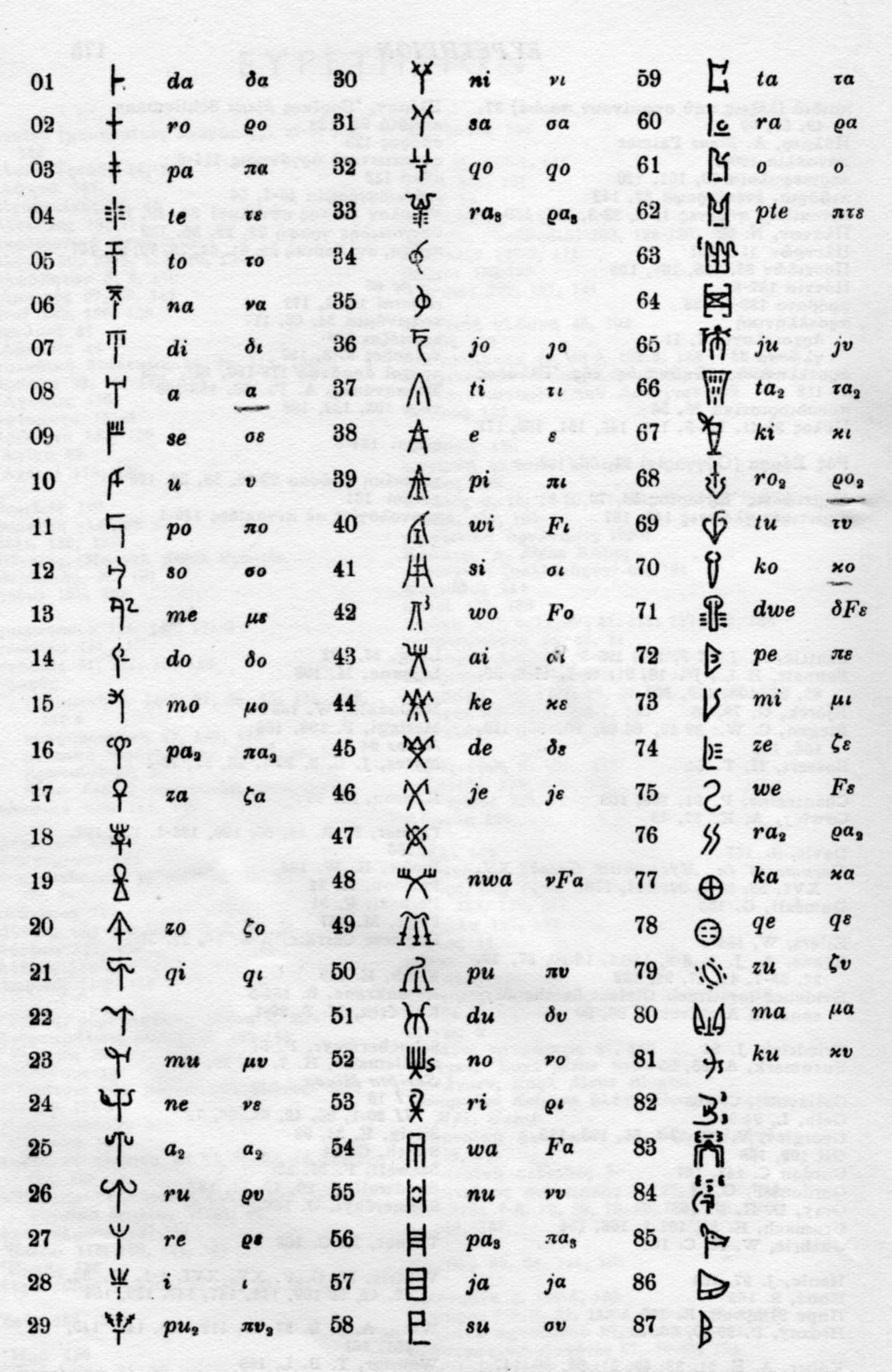
A table on page 176 of Chadwick’s book Linear B, The First Greek Script . (Γραμμική Β’ Η πρώτη Ελληνική γραφή).
The Director of the International Academy of Ancestral Discourse, Mr. Ioannis Chamizidis, who is also a researcher of the ancestral texts, according to the tables by I. Thomopoulos, Ventris and Chadwick and Gareth Owens, keeps on his studies on them, completing them with new phonetic values.
The new phonetic values that Mr. Ioannis Chamizidis has identified and uses in his readings, are more than 100.
The table in question is going to be suspended on this website in the near future.
Apart from the phonetic values that he has completed, he realized that, the Greek Classical Literature is not enough for the rendition of the ancestral texts. This rendition is complete with the aid of the Pontic and the Macedonian Dialects.
His knowledge about the Pontic and the Macedonian Dialects, is a kind of support when unknown words need to be added and cannot be found in the Greek Classical Literature.
A characteristic example is the word geto( γείτο), about which in his book
Linear B, The First Greek Script (Γραμμική Β’ Η πρώτη Ελληνική γραφή), Chadwick on page 89 testifies :
“I have searched but I have not found such a word in the Greek Literature. There is no Greek word matching to it”.
Touching this scientific view, Ioannis Chamizidis attests that he everyday uses the word geto( γείτο), when he talks with a Pontic Greek maker, telling him: ”χτίσον έναν γείτο” (make an accurate copy of that”.In the Pontic Dialect we say: γείτος-γείτενα-γείτο, αυτός-αυτή-αυτό (same, this). A speaker of the Pontic Dialect is so near, while the person who does not speak Pontic is so far away from that.
In the same text the word getorofe can also be found.
Nowadays the expression in the Present Imperative of the Pontic verb γητουρεύω (make, construct) , is γητούρεβε, (make, construct).
At this point, I could write that some phonetic values must be reviewed.
According to Mr. Chamizidis all local dialects contribute to the texts.
These are the Cretan, the Cypriot, the Western- Macedonian and mainly the Pontic Dialects, with other ones also being equally important.
The International Academy of Ancestral Discourse presents tables of phonetic values by other researchers, too.
A Syllabary of Linear A, on page 26 of the book The 147 Towns of Ancient Crete (Οι 147 πόλεις τηςΑρχαίας Κρήτης), by Antonis Vassilakis.
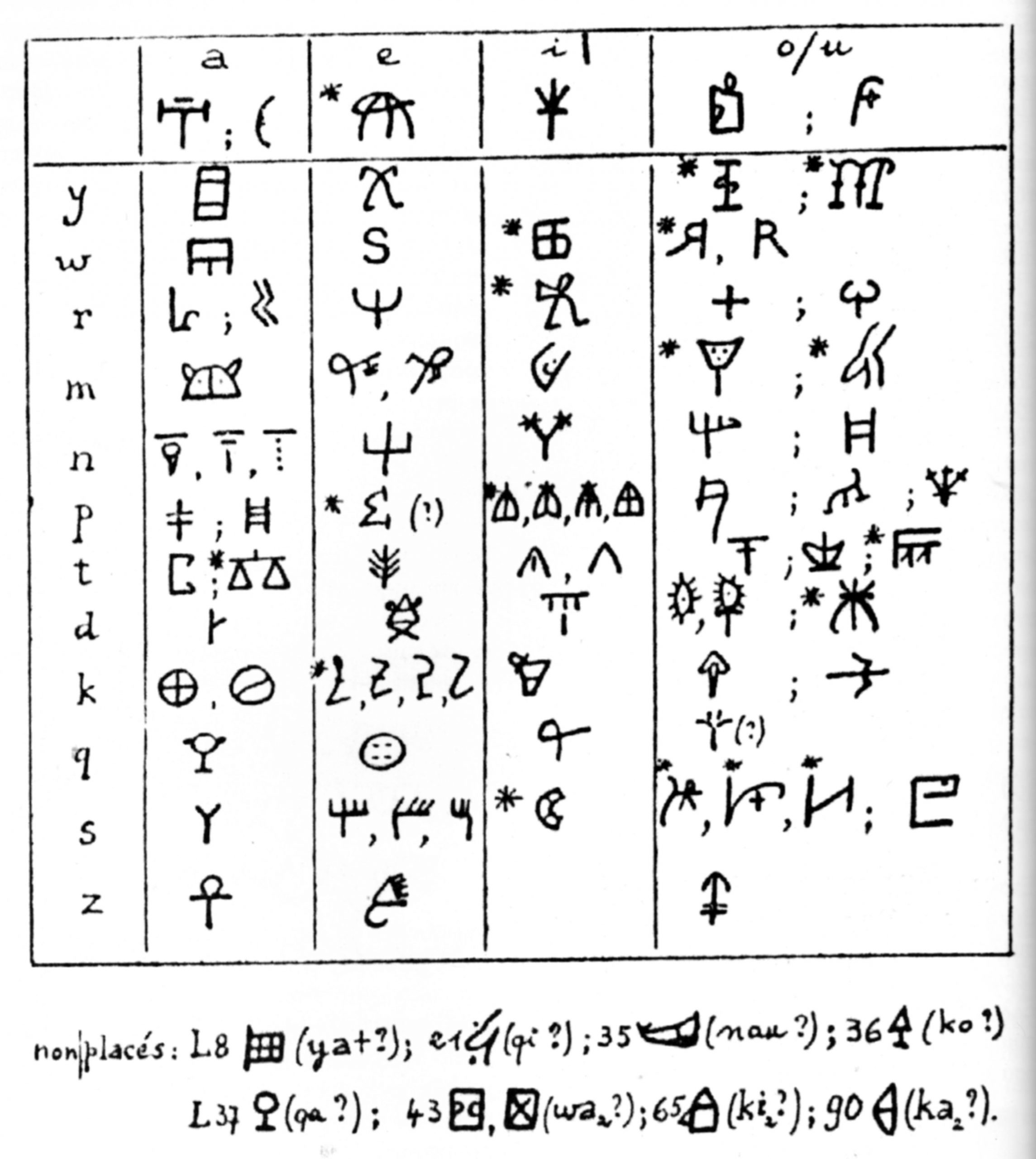
A Syllabary of Linear B, on page 27 of the book The 147 Towns of Ancient Crete (Οι 147 πόλεις τηςΑρχαίας Κρήτης), by Antonis Vassilakis.
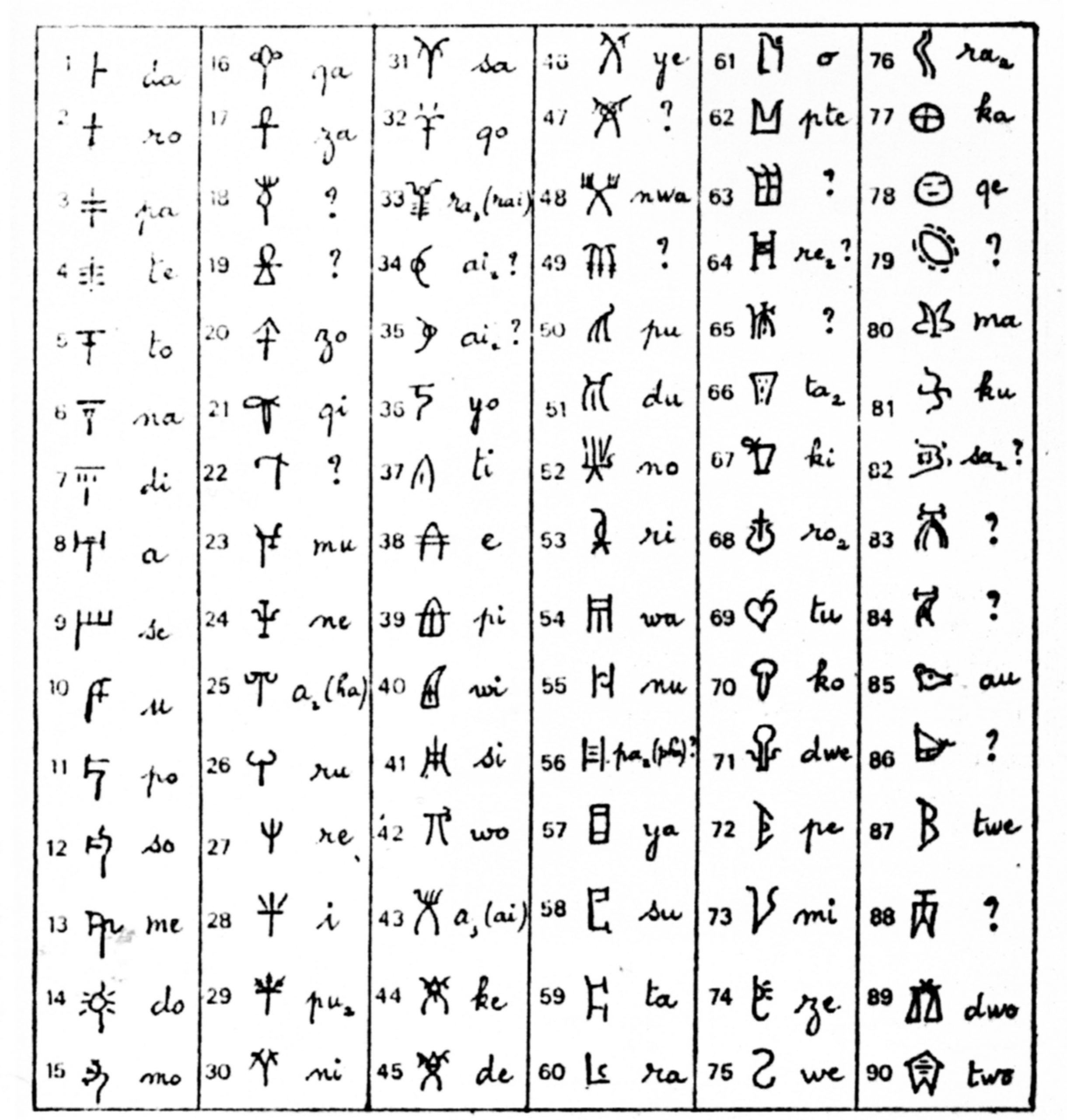
Syllabic phonetic values of Minoan Hieroglyphics, from page 28 of the book The 147 Towns of Ancient Crete (Οι 147 πόλεις τηςΑρχαίας Κρήτης), by Antonis Vassilakis.
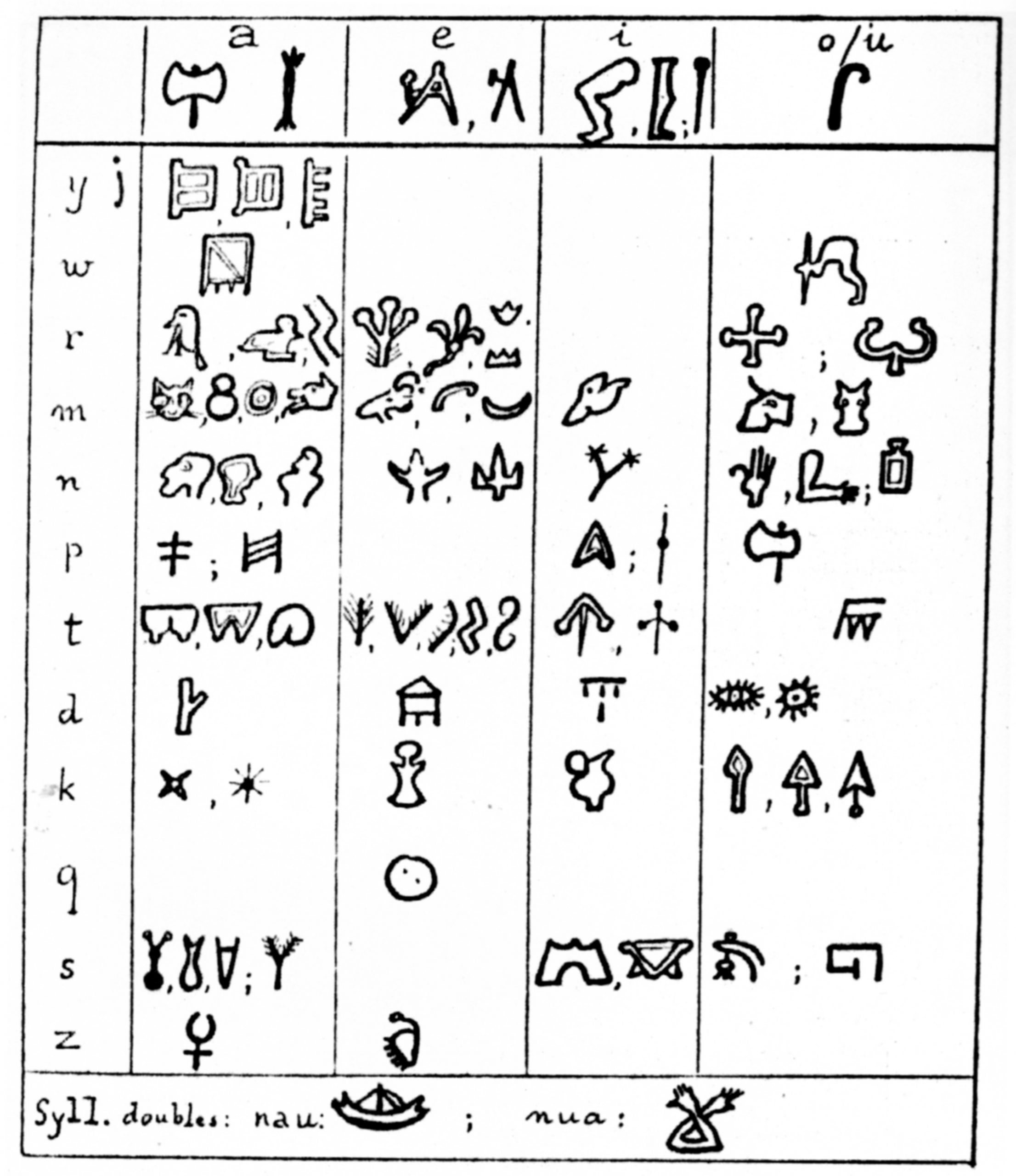
A Syllabary of phonetic values of the ideograms of the Phaistos Disc.
- The Latin pronunciation of the ideograms is that completed and phonetically rendered by Gareth In addition to that, however, it includes some extra phonetic renditions by Ioannis Chamizidis, as he has understood and expressed them. These are included on the same column, into the parentheses, so as to single out easily.
- In the Greek rendition, this Syllabary crystallizes the whole conclusion drawn by Ioannis Chamizidis, after a lot of studies of Linear Script, lasting many
SYLLABARY OF PHONETIC VALUES
LATIN PRONUNCIATION MEANING IN GREEK
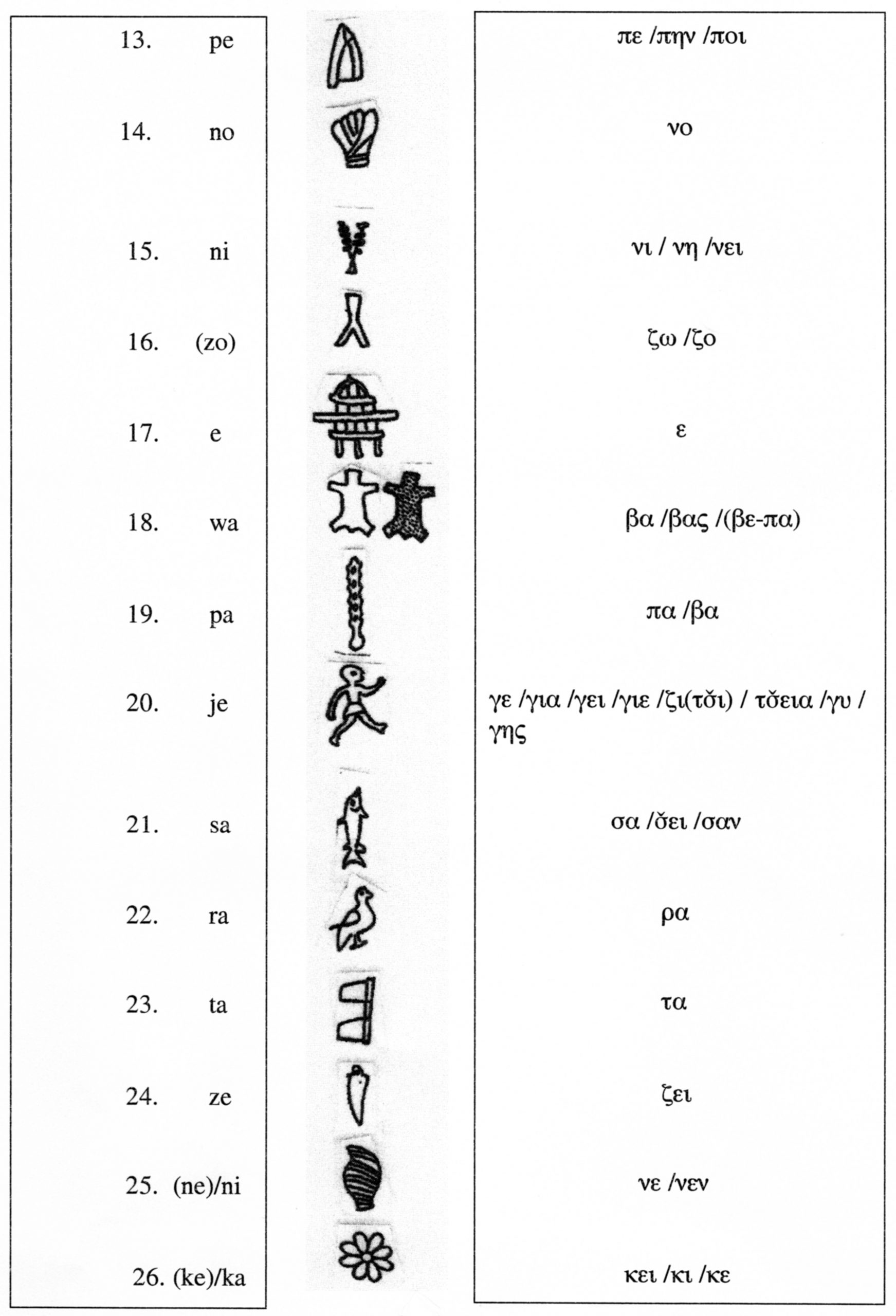
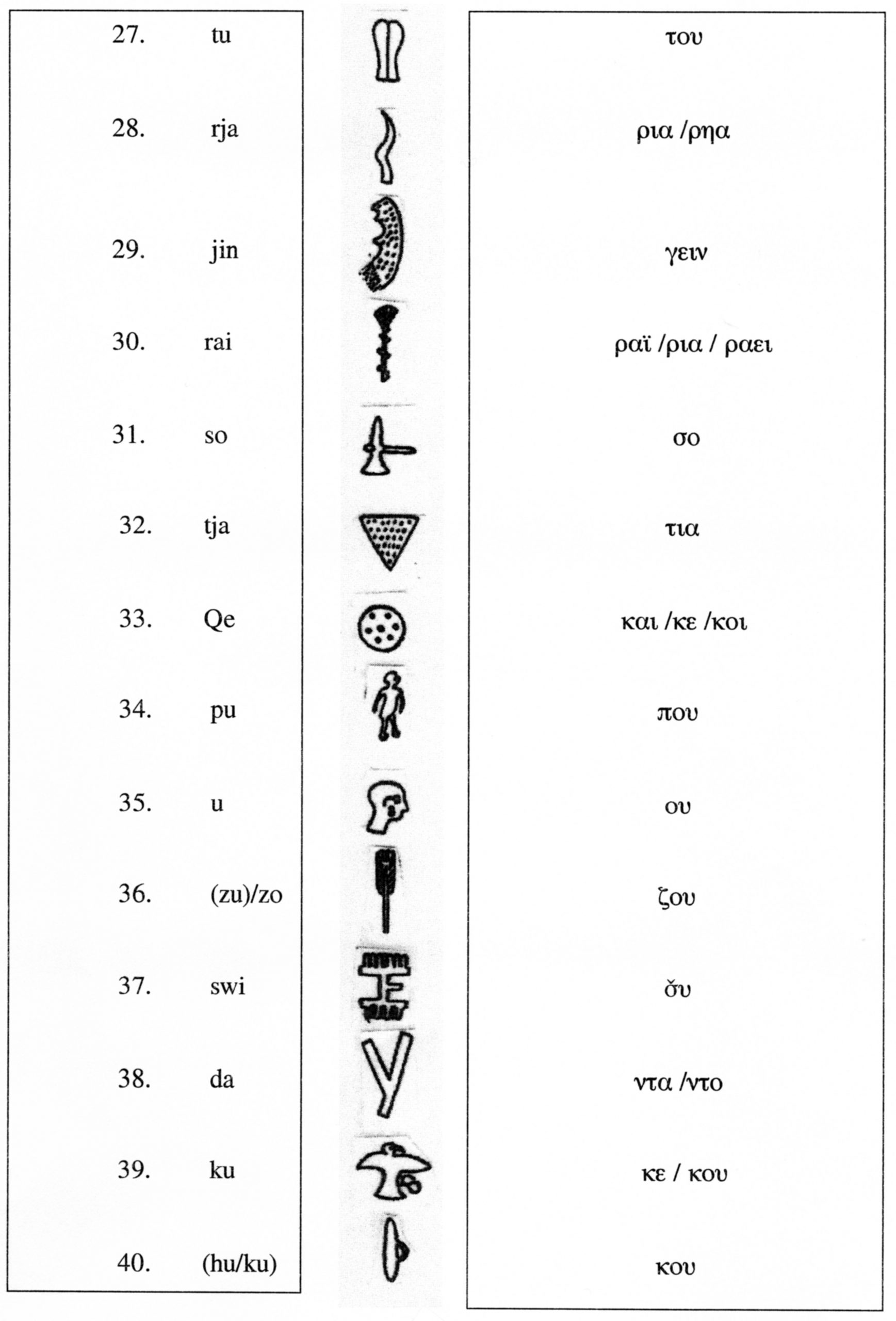
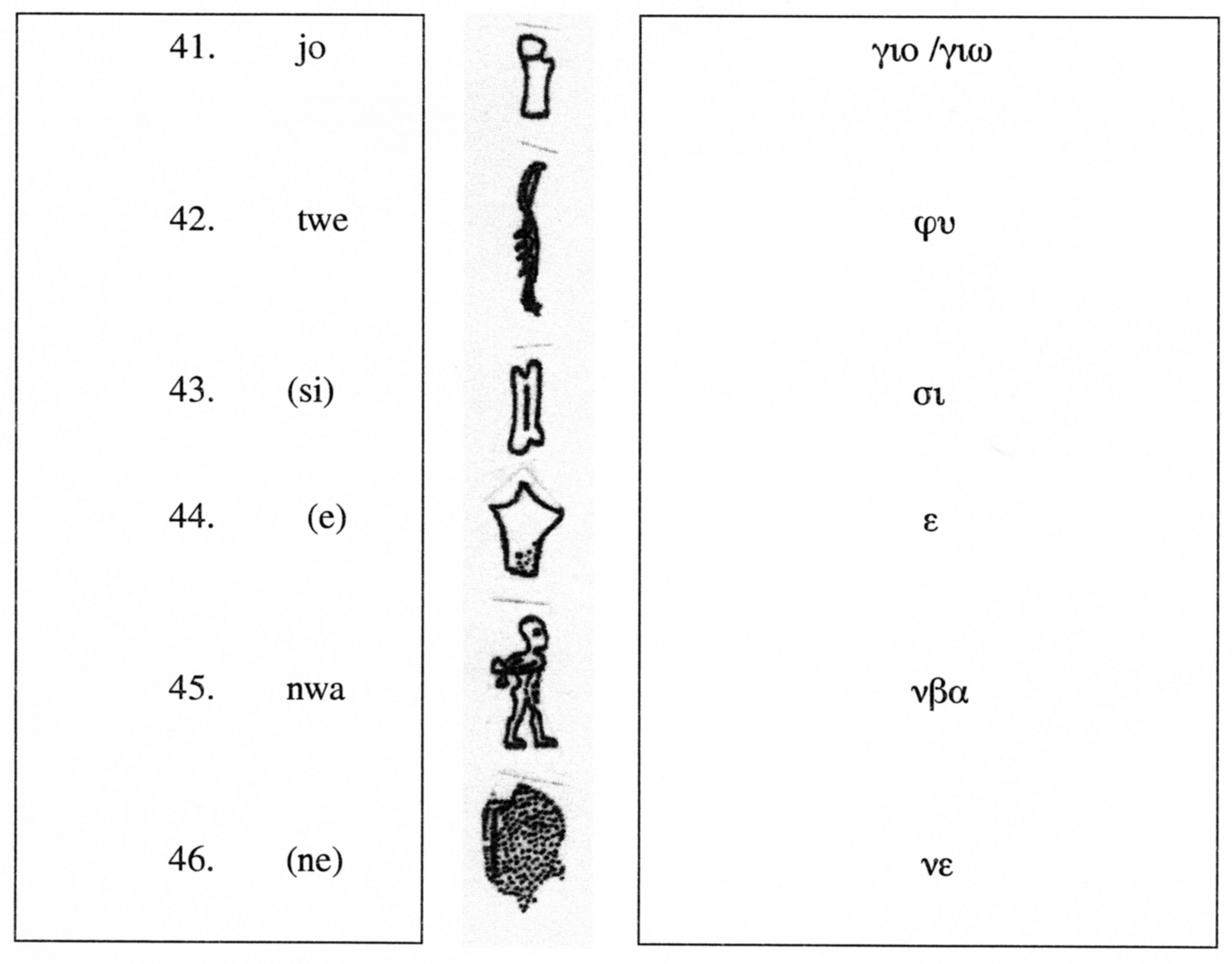
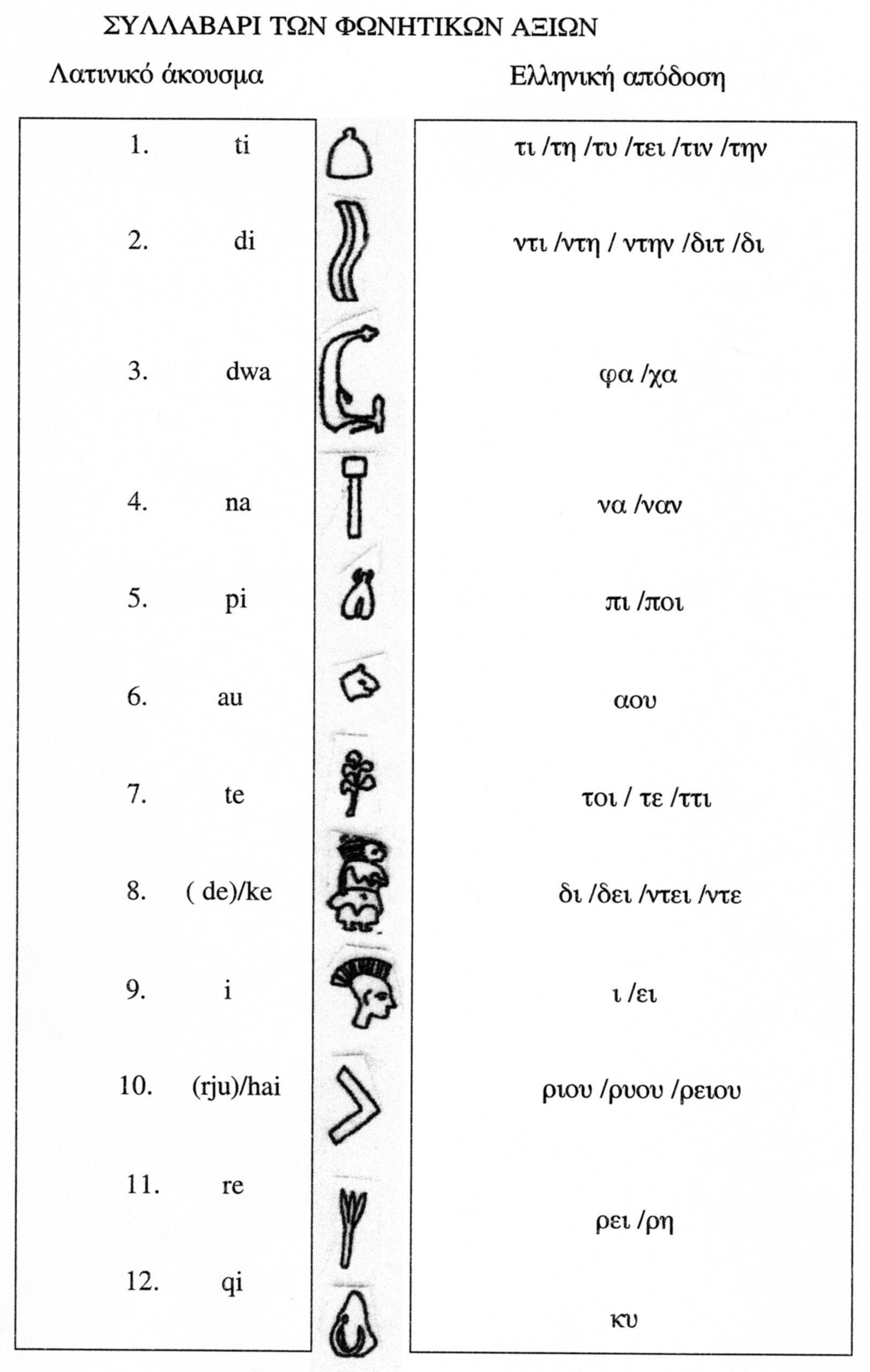
GENERAL BIBLIOGRAPHY
REFERENCES TO LINEAR SCRIPT
- Αntonis Vassilakis, The 147 Towns of Ancient Crete (Οι 147 Πόλεις της Αρχαίας Κρήτης), Kairatos Editions (Εκδόσεις Καίρατος), Irakleio 2000.
- Αntonis Keramopoulos , Research in Western Macedonia (Έρευναι εν Δυτική Μακεδονία), Proceedings of the Archaeological Company, Year 1938.
- Αntonis Keramopoulos, Excavations in Kastoria (Ανασκαφή εν Καστορία), Proceedings of the Archaeological Company, Year 1940
4.Gareth Owens, Labyrinth: Scripts and Languages of the Minoan and the Mycenaean Crete (Λαβύρινθος: Γραφές και Γλώσσες της Μινωικής και Μυκηναϊκής Κρήτης) ,Psychogios Editions (Εκδόσεις Ψυχογυιός,), Translated by Nikolidaki, Kallia, Irakleio 2007
5., Gareth Owens, Daedalus: Scripts and Languages of the Minoan and the Mycenaean Crete (Δαιδαλικά: Γραφές και Γλώσσες της Μινωικής και Μυκηναϊκής Κρήτης),Paterakis Editions (Εκδόσεις Πατεράκης), Αthens 1996.
6.Georgios Ch. Chourmouziadis, Dispilio of Kastoria. A lakeside Prehistoric Settlement (Το Δισπηλιό της Καστοριάς. Ένας λιμναίος Προϊστορικόςοικισμός),Thessaloniki 1996.
- Georgios Ch. Chourmouziadis, Dispilio 7.500 Years Later (Δισπηλιό 7500 χρόνια μετά), University Studio Press, Vivliodetiki (Βιβλιοδετική) Thessaloniki 2002.
- Greeks’ Network (Ελλήνων Δίκτυο) Egypt and Keftiu. Elements about the Minoan Language (Αίγυπτος και Κεφτίου. Στοιχεία για την Μινωική Γλώσσα), Website.
9.Iakovos Thomopoulos, Pelasgika (Πελασγικά), Pelekanos Editions (Εκδόσεις Πελεκάνος), First Edition in 1912, Second Edition in 2007, Αthens 2007.
- James T. Hooker, Introduction to Linear B (Εισαγωγή στην Γραμμική Β), National Bank of Greece Cultural Foundation (Μορφωτικό Ίδρυμα Εθνικής Τραπέζης),Translated by Charalambos Maravelias, Αthens 1994.
- John Chadwick, Linear Script B. The First Greek Script (Γραμμική Β’. Η Πρώτη Ελληνική Γραφή), Kakoulidis Editions (Εκδόσεις Κακουλίδης), Translated by Dimitrios Tzortzidis, Αthens 1962.
- 12. John Chadwick, Linear Script B and Relative Scripts (Γραμμική Β’ και Συγγενείς Γραφές), Papadimas Editions (Εκδόσεις Παπαδήμας), Translated by Nikolaos Konomis, Αthens
- John Chadwick, The Mycenaean World (Ο Μυκηναϊκός Κόσμος), Gutenberg Editions (Εκδόσεις Gutenberg), Translated by K. Petropoulos, Αthens 1999.
- Κ. Kotsakis, Ceramic Technology. Neolithic Culture in Greece (Κεραμική Τεχνολογία. Νεολιθικός Πολιτισμός στην Ελλάδα),N.P. Goulandris Foundation, Athens 1996
LANGUAGE AND LITERATURE SUPPORT
1.Anthimos Papadopoulos, Historic Dictionary of the Pontic Dialect (Ιστορικό Λεξικό της Ποντιακής Διαλέκτου), Myrtidis Editions (Εκδόσεις Μυρτίδη), Αthens 1961.
- 2. Vassiliki Vlachou, The Regular and Irregular Verbs of the Ancient Greek Language (Τα Ρήματα. Ομαλά-Ανώμαλα της Αρχαίας Ελληνικής), Gutenberg Editions (Εκδόσεις Gutenberg) ,Αthens
3.Ioannis Pantazidis, A Homeric Dictionary of all the Words of the Homeric Era (Λεξικόν Ομηρικόν. Περιέχον πάσας τας ευρισκομένας λέξεις παρ’ Ομήρωκαι τοις Ομηρίδες), Anestis Konstantinidis Editions (Εκδόσεις Ανέστη Κωνσταντινίδη), Αthens 1888.
- Ιoannis Chamizidis, The Greek Language of the East. An Interpretative and Etymologic Dictionary of the Pontic Discourse (Τα Ρωμαίικα τη Ανατολής. Ερμηνευτικό-Ετυμολογικό Λεξικό του Ποντιακούλόγου), ( an unpublished dictionary).
- Liddell-Scott, An Epitome of the Great Dictionary of the Greek Language (Επιτομή του Μεγάλου Λεξικού της Ελληνικής Γλώσσας), Vima Newspaper (Εφημερίδα Βήμα), Pelekanos Editions (Εκδόσεις Πελεκάνος), Αthens 2007.
- Νikolaos Laparidis, An Etymologic -Interpretative Dictionary of Pontic Words, Coming from the Ancient Greek Language (Ετυμολογικόν-Ερμηνευτικόν Λεξιλόγιον Ποντιακών Λέξεων Προερχομένωναπό την Αρχαία Ελληνική Γλώσσα), Kyriakidis Editions (Εκδόσεις Κυριακίδη), Thessaloniki 2002.
- Panayotis Yannakopoulos , Dictionary of the Modern Greek Language (Λεξικο της Νέας Ελληνικής Γλώσσας), Pelekanos Editions (Εκδόσεις Πελεκάνος), Αthens
- Souda or Souida, A Dictionary (Λεξικόν), Kaktos Editions (Εκδόσεις Κάκτος), Αthens 2004.
